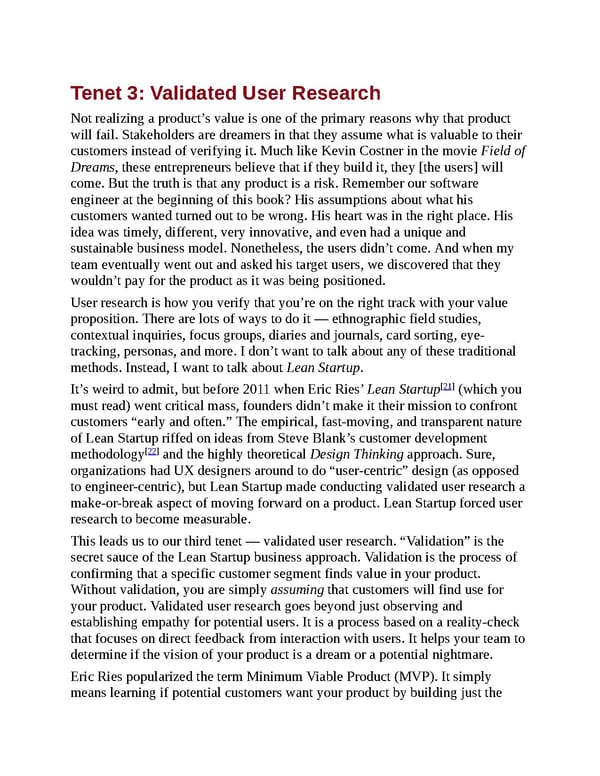Tenet 3: Validated User Research Not realizing a product’s value is one of the primary reasons why that product will fail. Stakeholders are dreamers in that they assume what is valuable to their customers instead of verifying it. Much like Kevin Costner in the movie Field of Dreams, these entrepreneurs believe that if they build it, they [the users] will come. But the truth is that any product is a risk. Remember our software engineer at the beginning of this book? His assumptions about what his customers wanted turned out to be wrong. His heart was in the right place. His idea was timely, different, very innovative, and even had a unique and sustainable business model. Nonetheless, the users didn’t come. And when my team eventually went out and asked his target users, we discovered that they wouldn’t pay for the product as it was being positioned. User research is how you verify that you’re on the right track with your value proposition. There are lots of ways to do it — ethnographic field studies, contextual inquiries, focus groups, diaries and journals, card sorting, eye- tracking, personas, and more. I don’t want to talk about any of these traditional methods. Instead, I want to talk about Lean Startup. [21] It’s weird to admit, but before 2011 when Eric Ries’ Lean Startup (which you must read) went critical mass, founders didn’t make it their mission to confront customers “early and often.” The empirical, fast-moving, and transparent nature of Lean Startup riffed on ideas from Steve Blank’s customer development [22] methodology and the highly theoretical Design Thinking approach. Sure, organizations had UX designers around to do “user-centric” design (as opposed to engineer-centric), but Lean Startup made conducting validated user research a make-or-break aspect of moving forward on a product. Lean Startup forced user research to become measurable. This leads us to our third tenet — validated user research. “Validation” is the secret sauce of the Lean Startup business approach. Validation is the process of confirming that a specific customer segment finds value in your product. Without validation, you are simply assuming that customers will find use for your product. Validated user research goes beyond just observing and establishing empathy for potential users. It is a process based on a reality-check that focuses on direct feedback from interaction with users. It helps your team to determine if the vision of your product is a dream or a potential nightmare. Eric Ries popularized the term Minimum Viable Product (MVP). It simply means learning if potential customers want your product by building just the
 UX Strategy: How to Devise Innovative Digital Products that People Want Page 42 Page 44
UX Strategy: How to Devise Innovative Digital Products that People Want Page 42 Page 44